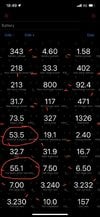I think closing the gap depends on which specific trims of the cars you're comparing. But using the chart from
this study, and eyeballing the average degradation of LFP vs nickel batteries, let's consider a hypothetical scenario. For the mileage, I'm assuming people average about 150 miles between charge cycles (not sure if I'm way off with that assumption).
At purchase:
2022 Model 3 RWD range: 272 miles (100 capacity remaining, 0 miles on odometer, daily 100% charge gives 272 miles)
2022 Model 3 LR range: 358 miles (100 capacity remaining, 0 miles on odometer, daily 80% charge gives 286 miles)
5 years after purchase:
2022 Model 3 RWD range: 258 miles (95% capacity remaining, 156,000 miles on odometer, daily 100% charge gives 258 miles)
2022 Model 3 LR range: 308 miles (86% capacity remaining, 156, miles on odometer, daily 80% charge gives 246 miles)
10 years after purchase:
2022 Model 3 RWD range: 250 miles (92% capacity remaining, 312,000 miles on odometer, daily 100% charge gives 250 miles)
2022 Model 3 LR range: 293 miles (82% capacity remaining, 312,000 miles on odometer, daily 80% charge gives 234 miles)
Note: I'm assuming four charge cycles per week, which equates to 208 cycles per year. So 5 years is about 1040 cycles and 10 years is about 2080 cycles. Obviously there are a ton of other variables too, like driving style, cycle SoC ranges, fast charging vs trickle charging, temperature, etc.
Also, this conflicts a bit with
Tesla's own statement that their batteries lose about 1% for every 20,000 miles driven. I'm assuming 150 miles per charge cycle, but using Tesla's claim with that same study implies people are only charging 500 cycles to reach 200,000 miles, which is a whopping 400 miles per charge. Maybe the discrepancy is because Tesla's battery design and BMS are just better at limiting degradation than your average batteries that are being tested in studies.
But using my estimates and the chart in that study, long-term you're better of with the LFP battery in terms of daily usable range. Not to mention that the LFP chemistry is far more stable and more environmentally friendly.
EDIT: Regarding the million mile claim...I've read that LFP batteries can get 5000-7000 cycles while maintaining over 80% of the battery's capacity. So yeah, those batteries should last a million miles. But I don't know if the rest of the car can last that long. So maybe after a car gets removed from service, those LFP batteries get upcycled for grid storage or home backup or something like that until they finally need to be recycled into new batteries.



